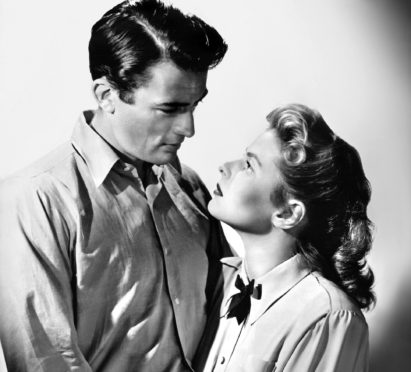
When you can afford to leave out a dream sequence by Salvador Dali, you must feel your movie is already more than good enough.
Thankfully, Spellbound really was so strong that the Dali dream was omitted without damaging the finished article.
Sadly, most of the 20-minute sequence is lost forever, but the movie itself remains one of Alfred Hitchcock’s many classics.
A film noir mystery thriller built around psychoanalysis and the tricks our minds can play, getting Salvador Dali on board for the dream sequence was a masterstroke.
It’s just a shame that this part of the original film was then deemed far too long, but the movie we know and love is still brilliant.
Spellbound is the story of a Vermont mental asylum which gets a new boss, only for the other staff to realise he is not quite who he claims to be.
When Dr Murchison, the hospital director, is forced to retire just after coming back to work from an absence with nervous exhaustion, they hire Dr Anthony Edwardes.
He is far younger than they expect him to be, and psychoanalyst Dr Constance Petersen takes a great interest in him.
The other doctors, all male, reckon Dr Petersen is a bit of an ice maiden, cool and aloof, and Ingrid Bergman plays her like she was born for the role.
The new young doctor is played by Gregory Peck, and he would much later reveal that they had clicked off the set as well as on it.
Based on the 1927 novel The House Of Dr Edwardes by Ben Hecht, it starts with Petersen observing Edwardes and finding no shortage of intriguing aspects to his character.
For one thing, he seems to have a phobia about parallel lines against a white background.
It also doesn’t escape her notice that his handwriting is not that of the real Dr Edwardes – this guy seems to be an imposter.
Before long, he confirms her suspicions, telling her he has amnesia and doesn’t actually know who he is, but that he killed the real Edwardes and is taking his place.
All great classic Hitch, of course, and despite what he tells her, Petersen reckons he is innocent and struggling with a guilt complex.
While she is still trying to get to grips with all this, everyone else learns that he is not the real Edwardes. He, they believe, has been murdered, and now the imposter has disappeared, too.
Petersen somehow manages to locate him, with the police in hot pursuit, with the man now calling himself John Brown, and the pair take a train to Rochester, New York.
Teaming up with another doctor friend, Brulov, the pair analyse the dreams of the man now known as John Brown.
Of course, we’ll never get to see that entire dream sequence to analyse it for ourselves, but the parts that were kept in the film include eyes, curtains, scissors and playing cards, some of which are blank.
It also features a man falling from a building, a man with no face and a man hiding behind a chimney, dropping a wheel and being pursued by large wings.
Very Dali, very Hitchcock, and very gripping to watch, 75 years ago when it was released, and just as gripping today.
The analysts reach the conclusion that the parallel lines were ski tracks and that Brown and Edwardes were on a ski trip and Edwardes dies.
It turns out, in fact, that the man with the guilt complex suddenly recovers from his amnesia and remembers a precipice in front of him and Edwardes falling to his death.
This leads to him recalling his childhood trauma, when he slid down a rail with his brother, and accidentally knocked him on to railings which killed him.
And he even remembers his real identity – John Ballantyne.
It is then, however, discovered that Edwardes had a bullet in him, and Ballantyne is sent to jail for murder.
Being a Hitch classic, the story is never going to be that simple.
Dr Murchison, back again as director of the asylum, lets slip that he knew and disliked Edwardes, leading Petersen to start analysing all over again.
The man behind the dream sequence chimney and dropping the wheel must have been Murchison, who must have shot him and then dropped the gun.
He owns up but threatens to kill her, too, but she talks him out of it and is reunited with Ballantyne, released from prison.
Alfred Hitchcock didn’t always click with producer David O Selznick, despite the pair coming up with some cracking movies.
Selznick had wanted this one to be based around his own experiences of psychoanalysis, even bringing his own therapist on to the project, but she and Hitch had not got on well.
Hitchcock, however, would be pleased with the end result, even with the bits missing, and he was also quietly chuffed with another of his own cameo appearances.
They made a big thing of his appearance, emerging from an Empire State Hotel elevator carrying a violin case and smoking a cigarette. Trailers even freeze-framed it, mentioning who he was, and the scene was shown twice.
As if any movie featuring Hitch, Dali, Bergman and Peck needed an extra push.
Spellbound (1945) – Talking Pictures, Sunday April 12, 1.45pm.

Enjoy the convenience of having The Sunday Post delivered as a digital ePaper straight to your smartphone, tablet or computer.
Subscribe for only £5.49 a month and enjoy all the benefits of the printed paper as a digital replica.
Subscribe